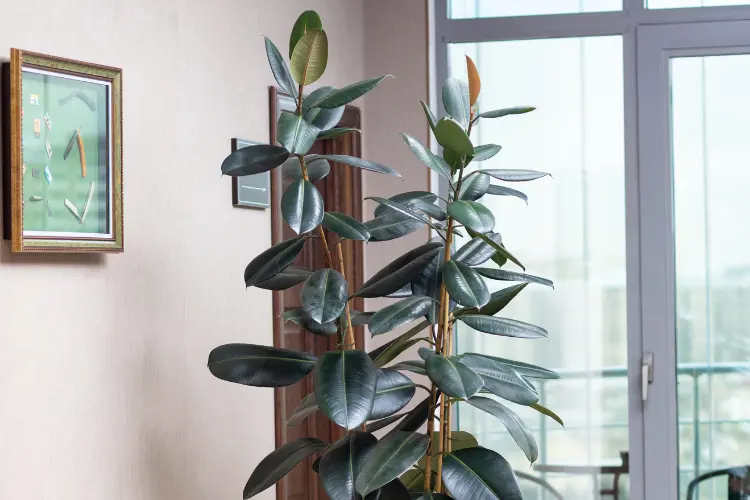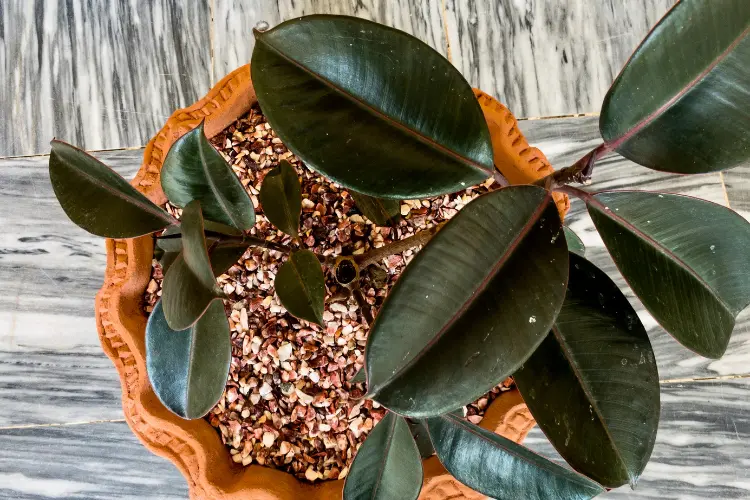
Unlock the Charm of Burgundy Rubber Plants in Your Home Decor and Gardening Journey
Explore how Burgundy Rubber Plants can add charm to your home decor and enhance your gardening journey. Learn about their care, benefits, and creative ways to incorporate them into your space.
Share This Post!
It’s not surprising that Burgundy Rubber Plants are popular with plant enthusiasts for both indoor and outdoor decor. Their lush foliage and striking appearance have made them a favorite among plant enthusiasts.
Here, we’ll give you a complete overview of Burgundy Rubber Plants, from their origins and care tips to creative ways to incorporate them into your home and garden.
It doesn’t matter if you’ve been gardening for years or if you’ve just started, these versatile plants will captivate your senses and elevate your living space.
Understanding Burgundy Rubber Plants
Burgundy Rubber Plants, scientifically known as Ficus elastica Burgundy, belong to the Moraceae family and are native to the tropical regions of Southeast Asia.
Known for their glossy leaves, they add a touch of elegance and drama to any setting with their large, deep burgundy to dark green leaves.
These plants are prized for their air-purifying qualities, making them not only aesthetically pleasing but also beneficial for indoor air quality.
Origins and Botanical Features
Burgundy Rubber Plants are native to India, Malaysia, and Indonesia, where they thrive in humid and indirect sunlight environments.
With their sturdy stems and waxy leaves, they make outstanding indoor potted plants as well as outdoor accents in temperate climates, because they can grow to impressive heights.
Characteristics of the Burgundy Rubber Plant
In the eyes of plant connoisseurs, the Burgundy Rubber Plant is a striking plant with attractive visual features. Its textural and tonal variety within its leaves can add depth and color to any room.
The ability of plants to grow to large, statement-worthy trees when left untrimmed makes them a great feature for interior landscapes.
Appearance and Growth Habits
The Burgundy Rubber Plant’s most defining feature is its large, elliptical leaves, which are typically between 8 to 12 inches long.

The vibrant maroon color of the foliage deepens in brighter light, adding warm tones to the environment.
In terms of size, these plants can grow to be quite tall, with some reaching ceiling height. However, through pruning, they can also be maintained as bushier, more compact plants, suited to smaller spaces.
Ideal Growing Conditions
To achieve the best growth, provide your Burgundy Rubber Plant with bright, indirect light. Keep the plant in a warm, humid environment, and avoid sudden temperature changes or drafts, which it may not appreciate.
Well-draining soil is essential to prevent waterlogging, while a balanced fertilizer applied in the growing season can promote healthy development.
Care Tips for Burgundy Rubber Plants
It is important to understand how to care for your Burgundy Rubber Plant in order to maintain its health and vitality.
The following guidelines will help you nurture your plant and see it thrive:
Light and Placement
Light:
Place your Burgundy Rubber Plant in bright, indirect sunlight. Direct sunlight can lead to leaf burn, while too little light may result in leggy growth.
Placement:
Choose a location with consistent temperature and avoid placing the plant near drafts or heating vents.
Watering and Humidity
Watering:
Water your plant when the top inch of soil feels dry to the touch. Avoid overwatering, as it can lead to root rot.
Humidity:
Burgundy Rubber Plants prefer moderate to high humidity levels. Mist the leaves occasionally or place a humidity tray nearby to maintain adequate moisture.
Soil and Fertilization
Soil:
Use well-draining, peat-based soil for optimal growth. Repot the plant every 2-3 years to refresh the soil and provide ample space for root development.
Fertilization:
Feed your Burgundy Rubber Plant with a balanced liquid fertilizer during the growing season (spring and summer) to support healthy foliage and growth.
Pruning and Maintenance
Pruning:
Trim any yellow or damaged leaves regularly to promote new growth and maintain a tidy appearance.
Maintenance:
Check for pests like spider mites or mealybugs periodically and treat them promptly to prevent infestations.
Common Issues and Solutions
Even the most savvy plant owners encounter problems, but with the Burgundy Rubber Plant, there are solutions to most issues.
Pests and Diseases
Keep an eye out for pests such as spider mites and scale. To combat these, use a gentle insecticidal soap or neem oil.
Diseases can also be a concern, particularly root rot from overwatering. Ensure the plant is potted in well-draining soil and that it is watered on a schedule that suits your environment and climate.
Troubleshooting Yellowing Leaves
Yellow leaves may indicate overwatering or exposure to too much direct sunlight. Adjust your watering and positioning to rectify these issues, and consider if the plant needs repotting into a container with better drainage.
Propagation Methods for the Burgundy Rubber Plant
The Burgundy Rubber Plant is relatively easy to propagate, allowing you to share the beauty of this plant with friends or expand your collection.
Propagation Through Cuttings
To propagate through cuttings, snip below a node and place the cutting in water or moist soil. Keep the cutting in a warm, well-lit area and wait for roots to develop.
Tips for Successful Propagation
When choosing a cutting, select a healthy stem and take it in the warmer months. Ensure the new plant receives ample humidity to encourage root growth.
Creative Ways to Incorporate Burgundy Rubber Plants into Your Decor
Have you ever wondered how to decorate your space with a Burgundy Rubber Plant?
The decorative potential of this wonderful plant can be maximized with a few simple guidelines.
1. Indoor Plant Stand Showcase
Create a captivating display by placing your Burgundy Rubber Plant on a stylish plant stand.
Choose stands in metallic finishes or natural materials like wood to complement the plant’s rich foliage.
2. Terrarium Terrific
Construct a mini terrarium using a glass container or a decorative bowl. Add pebbles, moss, and small accents like figurines to create a whimsical scene with your Burgundy Rubber Plant as the centerpiece.
3. Hanging Basket Elegance
Suspend your Burgundy Rubber Plant in a decorative hanging basket to add vertical interest to your space.
This not only saves floor space but also allows the plant to cascade gracefully, showcasing its lush leaves.
4. Outdoor Oasis
Incorporate Burgundy Rubber Plants into your outdoor garden or patio for a touch of tropical charm.
Pair them with other foliage plants or use them as focal points in planters to create a lush, inviting atmosphere.
Benefits of Growing a Burgundy Rubber Plant
Beyond its ornamental value, the Burgundy Rubber Plant offers several benefits, making it a valuable addition to any space.
1. Air Purification Properties
Burgundy Rubber Plants are excellent air purifiers, removing toxins like formaldehyde and benzene from indoor spaces, thus promoting a healthier environment.
2. Low Maintenance:
These plants are relatively low maintenance, requiring moderate watering and indirect sunlight, making them suitable for busy individuals or beginners in gardening.
3. Aesthetic Appeal
With their striking foliage and vibrant color variations, Burgundy Rubber Plants add a touch of sophistication and visual interest to any room or garden.
4. Versatile Use
From being standalone potted plants to key elements in landscape design, Burgundy Rubber Plants offer versatility in decor and gardening projects.
Conclusion
Burgundy Rubber Plants are not just decorative elements but also contribute to a healthier indoor environment and provide endless opportunities for creative expression in home decor and gardening.
With proper care and imaginative styling, these plants can transform any space into a vibrant oasis of natural beauty and charm.
